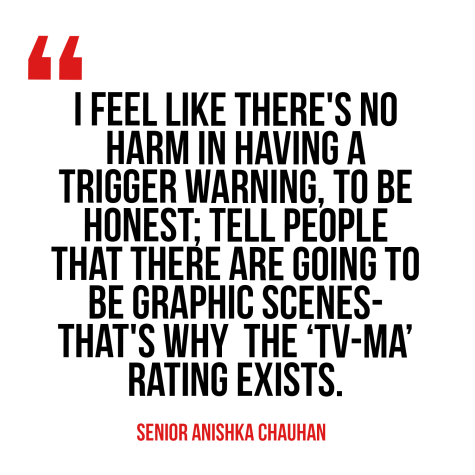Warnings and triggers
September 19, 2022
Like “Berserk,” shows like “Game Of Thrones” and movies such as “The Last Duel” all come with forewarning about their content, with censorship boards giving them 18+ ratings for their depictions of graphic violence and dark imagery. There are also various rating systems that apply to different forms of media. Shows like “Game Of Thrones” receive a “TV-MA” rating in the U.S. for its depictions of what is labeled adult content: graphic violence, sexual content and strong language. The same criteria applies to R-rated movies like “The Last Duel,” which are meant to target audiences ages 17 and older.
In contrast, Japanese media is divided into publishing platforms that aim to appeal to not only age groups but also to specific gender stereotypes. Manga such as “Berserk” take the label of a “Seinen” manga, meaning that it is published in a magazine to be read by young adult men between the ages of 18 and 40.
“Game of Thrones” openly depicts rape in extensive scenes, according to Chauhan, and she finds this drawn out brutality to be excessive, stating that it’s too long and overstays its welcome.
“[Shows] don’t have to show the actual graphic scene of somebody undergoing sexual violence,” Chauhan said. “I think that is disgusting. I know ‘Game of Thrones’ definitely has shown those and I have skipped through them, closed the tab and everything. [I’ve thought], ‘What the heck did I just watch?’ In those cases I’m just like, why do we need to know all the little details about sexual violence? It’s something that’s traumatic, it’s something that for somebody wh o has been through that to witness those details — no, it’s disgusting.”
However, the inclusion of sexual harrassment and abuse in media is an occasional practice, which for Chauhan means unexpected encounters with content she finds uncomfortable to watch. Stating that she’s skipped multiple episodes at times because of their inclusion of sexual violence, Chauhan stresses the responsibility of a show’s creator to uphold a trigger warning before each episode.
“I feel like there’s no harm in having a trigger warning, to be honest; tell people that there are going to be graphic scenes- that’s why the ‘TV-MA’ rating exists,” Chauhan said. “That’s why when you watch a television show, they tell you what the rating is in the corner. I don’t see why you can’t do it for individual episodes as well. It’s just common decency [to tell] somebody who might be traumatized or has some previous trauma towards sexual violence ‘Hey, this show for your own entertainment has some scenes that might make you diverge from the [entertainment]- you might want to have fun but it’s going to remind you of something traumatic.”

While acknowledging that trigger warnings are helpful for people wanting to avoid content, Anumala finds that there needs to be a middle ground as to how much directors or authors can reveal about their story lines. He also finds that a growing popularity of such content opens a gateway for people to be more comfortable with talking about topics like this.
“I think [the portrayal of sexual violence in movies] is a good thing,” Anumala said. “We’re talking about it with, and especially with Me Too, I think it’s a good thing that we’re finally talking about it in our literature. It’s a step ahead, we’re progressing. Obviously we want to make sure that this never happens again to anyone and I think displaying it as a horrifying element of life kind of makes it better in the sense that it won’t happen again- like they’ll irk, they’ll shiver a little bit. They’ll feel for the person getting attacked. It’s all about creating empathy through learning.”

















